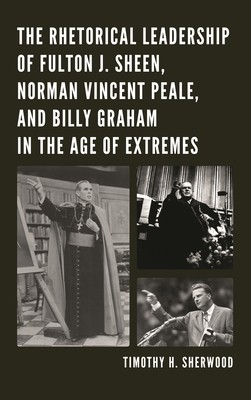
- We will send in 10–14 business days.
- Author: Timothy H Sherwood
- Publisher: Lexington Books
- ISBN-10: 149851586X
- ISBN-13: 9781498515863
- Format: 15.2 x 22.6 x 1.3 cm, minkšti viršeliai
- Language: English
- SAVE -10% with code: EXTRA
The Rhetorical Leadership of Fulton J. Sheen, Norman Vincent Peale, and Billy Graham in the Age of Extremes (e-book) (used book) | bookbook.eu
Reviews
Description
Fulton J. Sheen, Norman Vincent Peale, and Billy Graham were America's most popular religious leaders during the mid-twentieth century period known as the golden years of the Age of Extremes. It was part of an era that encompassed polemic contrasts of good and evil on the world stage in political philosophies and international relations. The 1950s and early 1960s, in particular, were years of high anxiety, competing ideologies, and hero/villain mania in America. Sheen was the voice of reason who spoke against those conflicting ideologies which were hostile to religious faith and democracy; Peale preached the gospel of reassurance, self-assurance, and success despite ominous global threats; and Graham was the heroic model of faith whose message of conversion provided Americans an identity and direction opposite to atheistic communism. This study looks at how and why their rhetorical leadership, both separately and together, contributed to the climate of an extreme era and influenced a national religious revival.
EXTRA 10 % discount with code: EXTRA
The promotion ends in 22d.13:35:15
The discount code is valid when purchasing from 10 €. Discounts do not stack.
- Author: Timothy H Sherwood
- Publisher: Lexington Books
- ISBN-10: 149851586X
- ISBN-13: 9781498515863
- Format: 15.2 x 22.6 x 1.3 cm, minkšti viršeliai
- Language: English English
Fulton J. Sheen, Norman Vincent Peale, and Billy Graham were America's most popular religious leaders during the mid-twentieth century period known as the golden years of the Age of Extremes. It was part of an era that encompassed polemic contrasts of good and evil on the world stage in political philosophies and international relations. The 1950s and early 1960s, in particular, were years of high anxiety, competing ideologies, and hero/villain mania in America. Sheen was the voice of reason who spoke against those conflicting ideologies which were hostile to religious faith and democracy; Peale preached the gospel of reassurance, self-assurance, and success despite ominous global threats; and Graham was the heroic model of faith whose message of conversion provided Americans an identity and direction opposite to atheistic communism. This study looks at how and why their rhetorical leadership, both separately and together, contributed to the climate of an extreme era and influenced a national religious revival.


Reviews